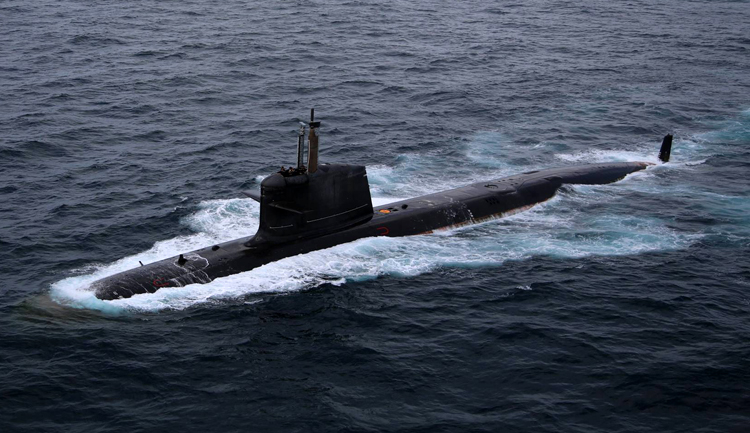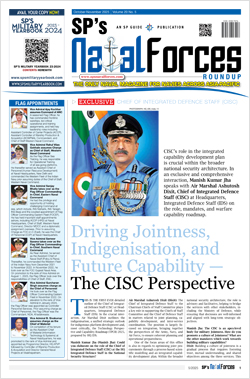INDIAN ARMED FORCES CHIEFS ON OUR RELENTLESS AND FOCUSED PUBLISHING EFFORTS

The insightful articles, inspiring narrations and analytical perspectives presented by the Editorial Team, establish an alluring connect with the reader. My compliments and best wishes to SP Guide Publications.

"Over the past 60 years, the growth of SP Guide Publications has mirrored the rising stature of Indian Navy. Its well-researched and informative magazines on Defence and Aerospace sector have served to shape an educated opinion of our military personnel, policy makers and the public alike. I wish SP's Publication team continued success, fair winds and following seas in all future endeavour!"

Since, its inception in 1964, SP Guide Publications has consistently demonstrated commitment to high-quality journalism in the aerospace and defence sectors, earning a well-deserved reputation as Asia's largest media house in this domain. I wish SP Guide Publications continued success in its pursuit of excellence.
- Global Partners Urged to Tap India's Shipbuilding Potential: Rajnath Singh at Samudra Utkarsh
- All about HAMMER Smart Precision Guided Weapon in India — “BEL-Safran Collaboration”
- India, Germany deepen defence ties as High Defence Committee charts ambitious plan
- G20 Summit: A Sign of Global Fracture
- True strategic autonomy will come only when our code is as indigenous as our hardware: Rajnath Singh
- India–Israel Joint Working Group Meeting on defence cooperation to boost technology sharing and co-development
Hiccups in Project 75(I)
It remains to be seen whether the foreign OEMs will be satisfied with whatever changes the MoD has made in the tender document and how many will respond by the December 2022 deadline
 |
The Author is Former Director General of Information Systems and A Special Forces Veteran, Indian Army |

In 1997, the Ministry of Defence (MoD) had approved a plan to acquire 24 submarines under Project 75. Following the Kargil Conflict in 1999, the Cabinet Committee on Security (CCS) approved the older submarine building plan spanning 30 years that called for two parallel production lines, each constructing six submarines. Project 75 (P-75) was brought under the new plan, with the two production lines to be built under P-75 and Project 75 (India) or P-75(I) using transfer of technology (ToT) from foreign manufactures.
In 2008, a Request for Information (RFI) was issued by the Indian Navy for six submarines to be built in India with air-independent propulsion (AIP) and land-attack capability. However in 2010, the MoD decided to import two submarines, build three at Mazagon Docks Limited (MDL)) and one at Hindustan Shipyard Limited (HSL), with a budget of 50,000 crore approved later. The Navy then issued a second RFI in September 2010 but this was not approved by the CCS because of conflicting views between the MoD and the Navy plus involvement of private shipyards.
MoD has cleared "key changes" in the tender document issued to allay fears of foreign firms, especially in the context of liability
In October 2014, the Defence Acquisition Council (DAC) headed by the Defence Minister decided to construct all six submarines in India and approved a budget of 53,000 crore. MDL, HSL and Cochin Shipyard Limited (CSL) were allowed bids in collaboration with foreign Original Equipment Manufacturers (OEMs). In 2017, the Navy issued another RFI but out of the six addresses, only Naval Group, Rosoboronexport, ThyssenKrupp Marine Systems (TKMS) and Saab responded. In June 2017, the MoD decided that the contract for construction of the submarines would be awarded under the new 'Strategic Partnership (SP) policy.
In April 2019, the MoD issued an Expression of Interest (EoI) for six submarines capable of firing land-attack missiles and anti-ship cruise missiles. Daewoo Shipping & Marine Engineering (DSME) was allowed to enter the competition. In September 2019, Saab withdrew from the competition, citing concerns about the rules defined in the SP policy, leaving five firms to contest for the P-75I project.



On January 21, 2020, the MoD shortlisted two Indian shipyards for the P-75(I) project - Larsen & Toubro (L&T) and MDL. Concurrently, the GoI also shortlisted five foreign OEMs as finalists in the P-75(I). These were Naval Group of France, Rubin Design Bureau of Russia, ThyssenKrupp Marine Systems (TKMS) of Germany, Navantia of Spain and DSME from Korea. L&T and MDL were required to collaborate with the five foreign shortlisted OEM's, for competing in the project.
As mentioned above, the P-75(I), under which six state of art conventional submarines are to be built with AIP system allowing them to remain under water for longer duration is being pursued under strategic partnership. On July 20, 2021, the MoD formally issued an RFP for the construction of six submarines, worth 43,000 crore under the SP model. The initial deadline for responding to the RFP was November 2021. However, this had to be changed to November 2022, followed by a second postponement of the deadline to December 2022.
The postponement of the deadline for response to the RFP is because the Naval Group of France and Rubin Design Bureau of Russia have officially intimated their inability to take part in the programme. According to one media report, one of the primary reasons for their withdrawal reportedly is the Navy's insistence to have a "proven" AIP.
Russia has publicly spoken out against P-75(I) project saying that "drastic changes" were needed in the tender for the project for the programme to come through
But "proven" AIP technology may not be the primary reason, especially since the Navy has reportedly not received any such intimation from L&T and MDL. After all, AIP technology would be with most of these foreign OEMs, if not all. Also the reason of SAAB withdrawing earlier from the P-75(I) project reportedly was because of the SP model.
News reports of August 26, 2022, now say that the MoD has cleared "key changes" in the tender document issued to allay fears of foreign firms, especially in the context of liability. A day earlier on August 25, Vice Chief of Naval Staff, Vice Admiral S.N. Ghormade, said that the defence ministry has cleared the responses to "some of the queries" put forward by the Indian companies and these will be sent out soon.
On the issue of insistence of proven AIP, the media has quoted an unnamed source, who said, "You can't say you will carry out trials at Indian Navy cost and see whether the system is actually working or not. P-75(I) is crucial and cannot be delayed and hence the insistence on proven AIP technology." Significantly, the August 26 news report goes on to say that Russia has publicly spoken out against P-75(I) project saying that "drastic changes" were needed in the tender for the project for the programme to come through.
According to Andrey Baranov, Deputy Director General, Foreign Economic Activities at Russia's Rubin Design Bureau, the RFP demands a very strict timeline and plenty of responsibility to the designer who has no influence on the construction process that will happen in India. If timelines are not met, the penalty is very high, from the very beginning we have said it is not possible to make the first submarine in such a short time, and, the RFP was issued without addressing this concern.
Most of the European contenders have withdrawn under pressure from the US who wants India to cut ties with Russia
Whether the foreign OEMs will be satisfied with whatever changes the MoD has made in the tender document, how many will respond by the December 2022 deadline and when would Project 75(I) take off is anybody's guess. It is also possible that while Russia finds the construction time too short because of its involvement in the Ukraine conflict, most of the European contenders have withdrawn under pressure from the US who wants India to cut ties with Russia. After all, the US did switch off the GPS during the 1999 Kargil Conflict to deny the Indian Navy from blockading the Karachi Harbour. That would leave South Korea's DSME the lone contender, which our bureaucracy will strike down on the plank of "single vendor" situation.
But looking at the above chain of events since 1997 when the MoD approved a plan to acquire 24 submarines, it is clear that there is no urgency at the policy makers level who care little about the evolving maritime threats in the region. Decisions towards the modes of procurement and procurement procedures are changed periodically, there is no effort to cut down the red tape, and the fact that this delays result at an exponentially higher procurement costs is ignored – perhaps by design.





